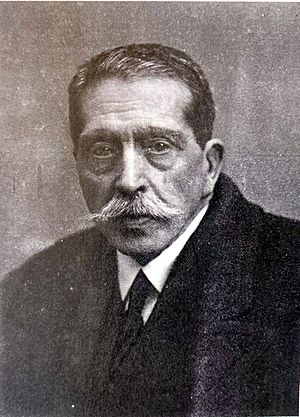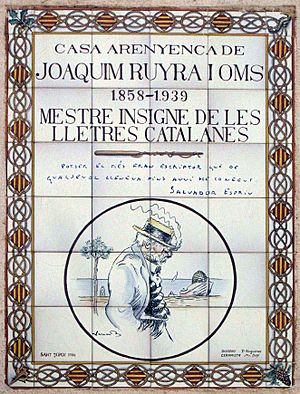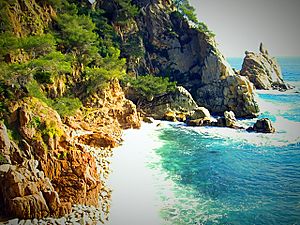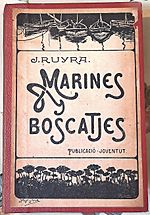Joaquim Ruyra facts for kids
Quick facts for kids
Joaquim Ruyra i Oms
|
|
|---|---|
 |
|
| Born | 27 October 1858 Girona, Catalonia |
| Died | 15 May 1939 (aged 80) Barcelona, Catalonia |
| Occupation | Writer, poet |
| Notable works | Marines i boscatges, Pinya de rosa, La parada |
| Top - 0-9 A B C D E F G H I J K L M N O P Q R S T U V W X Y Z |
Joaquim Ruyra i Oms (born October 27, 1858 – died May 15, 1939) was a famous Catalan writer, poet, and translator. He is known as a very important person in modern Catalan literature. Many people consider him one of the best storytellers of the 20th century.
Besides writing, Joaquim Ruyra was also interested in how languages work. He took part in the First International Congress of Catalan Language in 1906. Later, in 1918, he joined the Philological Section of the Institut d'Estudis Catalans. This group helps to make the Catalan language standard. He worked with other experts like Pompeu Fabra to create a clear and unified language system.
About Joaquim Ruyra
Joaquim Ruyra came from a family of farmers and lawyers. He studied law at the University of Barcelona from 1875 to 1881. However, he never worked as a lawyer. Instead, he chose to focus completely on writing.
Ruyra spent most of his childhood and youth in Girona and Blanes. Blanes is a coastal town in the la Selva region of Catalonia. He settled there after marrying Teresa de Llinàs in 1889. The couple also had homes in Barcelona and Arenys de Mar.
Blanes became the main setting for his stories. There, he learned about the local dialect, called salat. He also listened to the real way fishermen and peasants spoke. He later used these natural ways of speaking in his books. In 1926, Ruyra told an interviewer:
Blanes is my history, my homeland, the place for which I have greatest affection. I have lived there almost all my life. I got married there, my parents died there. It is only fair, then, that almost all my memories are of Blanes.
In the summer of 1928, a big wildfire destroyed the cork oak forests on his land. These forests were in the Gavarres mountains. This event affected the nature that inspired his best writings. After this, he mostly stopped writing new literary works.
During the Spanish Civil War, he first lost his property. But later, on his 80th birthday, he was honored. The Institució de les Lletres Catalanes held an official ceremony for him. He passed away quietly in May 1939, during the war. He was buried in the Blanes town cemetery.
His Writings
When he was young, Joaquim Ruyra started writing in Spanish. At that time, Spanish was often seen as the language for important cultural works. But soon, he switched to his mother tongue, Catalan. He was inspired by the famous poet Jacint Verdaguer, whom he met.
Ruyra became active in the literary scene in Barcelona, Blanes, Girona, and Olot. He won many prizes in the Floral Games (Jocs florals) contests in the late 1800s and early 1900s. He also wrote for several Catalan magazines and newspapers. These included La Renaixença, La Veu de Catalunya, and Joventut.
Ruyra wrote in many different styles. These included stories, poems, plays, essays, and literary criticism. But he is most famous for his short stories. These stories are found in books like Marines i boscatges (meaning Seascapes and Woodland Scenes, 1903). This book was later made bigger and republished as Pinya de rosa (meaning The End Knot, 1920). Another important collection is La parada (meaning The Trap, 1919).
His third book of stories was Entre flames (meaning Among Flames, 1928). He dedicated this book to the people affected by the Gavarres forest fires. The next year, a philosophical story called Sociòlegs d'ultratomba (meaning After-death Sociologists, 1929) appeared. Some of his stories have been translated into Spanish, English, French, German, and Italian. People have even compared his writing to famous authors like Herman Melville and Ernest Hemingway.
Ruyra also wrote three chapters of a novel that was never finished (La gent del mas Aulet, 1904). He wrote a short novel called Les coses benignes (meaning The Benign Things, 1925). He also published two collections of poems: Fulles ventisses (meaning Windy Leaves, 1919) and La cobla (meaning The Cobla, 1931). On top of all this, he translated French writers like Molière into Catalan.
His Impact

Joaquim Ruyra was a leader in the Catalan Modernist movement. This was a time after 1860 when Catalan writers created new ways of writing. The Catalan language became important for showing Catalan culture. Even though Ruyra did not write a huge number of books, his short stories set a high standard for Catalan literature. He helped shape how landscapes were described in stories. His use of language greatly influenced many great Catalan writers. These include Josep Carner, Josep Pla, and Mercè Rodoreda. The writer Salvador Espriu even said he learned from Ruyra. He called Ruyra "possibly the greatest writer I have known to date in any language."
Today, people in Blanes still remember Ruyra fondly. The town offers a special literary tour. This tour explores places that inspired his short stories. These places include the shipyards, the cove of Sa Forcanera, and the Sanctuary of El Vilar. Also, a promenade (a walkway by the sea) and a local public school are named after him.
In 1958, a monument was built on the seafront to honor Ruyra's 100th birthday. In 1989, a plaque was placed on his family home. This home is known as Can Creus, on Main Street. The plaque says: "Joaquim Ruyra i Oms, devoted son of Blanes and master of Catalan prose." The house where he lived in Arenys de Mar also has a ceramic plaque on its front.
Since 1963, the Enciclopèdia Catalana Foundation and La Galera publishing house give out the Joaquim Ruyra Prize. This award is for young adult fiction. It is given during the Nit de Santa Llúcia ("Saint Lucy's Night"). This is one of the most important cultural events for Catalan-language literature.
Images for kids
See also
 In Spanish: Joaquim Ruyra para niños
In Spanish: Joaquim Ruyra para niños




